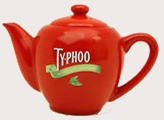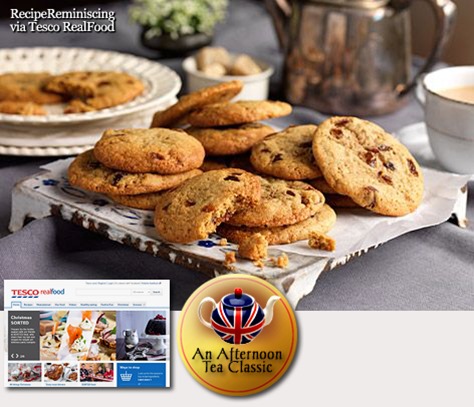
Typhoo’s Beginings
Typhoo’s origins are located in Birmingham . By the turn of the 20th century, Birmingham had over sixty tea merchants selling mostly large leaf tea.
 The founder of Typhoo, John Sumner, was born 26 February 1856 in Birmingham. His grandfather (William) and father (John) had established a grocery business in the Bull Ring in Birmingham.
The founder of Typhoo, John Sumner, was born 26 February 1856 in Birmingham. His grandfather (William) and father (John) had established a grocery business in the Bull Ring in Birmingham.
In the early 1900s John Sumner senior, now in his seventies, left the running of the shop to his son. John junior was happy with the successful business but had long sought a speciality product to develop. The answer came from his sister Mary Augusta. She suffered from indigestion and had tried a special tea made from tiny particles, not the large leaf variety that was common. The tea brought her great relief from her indigestion and she approached John to suggest he sold the tea in his shop.

John decided to go ahead. He bought 30 chests of tea and spent £200 on advertising, even though his friends suggested he might be wasting his money. John decided that, instead of selling the tea loose over the counter, he would packet the tea under a brand name. The criteria he placed on choosing a name for his tea were:
The name must be distinctive and unlike others
It must be one which would trip off the tongue
It must be one which could be protected by registration
 He finally settled on Typhoo Tipps. Typhoo meaning, in part, the Chinese word for doctor. The double p in Tipps was originally a printing error but remained misspelt on the packets of tea for many years.
He finally settled on Typhoo Tipps. Typhoo meaning, in part, the Chinese word for doctor. The double p in Tipps was originally a printing error but remained misspelt on the packets of tea for many years.
Typhoo was the first brand of tea to be sold pre-packaged rather than loose over the counter. In order to encourage his customers to purchase the tea John gave away a jar of cream to each person that bought a pound packet. The tea quickly became popular and John’s customers were becoming loyal to the brand that. Word of mouth recommendation from John’s customers led beyond his regular clientele and soon other grocers were asking to purchase the Typhoo tea, inspiring John to set up his wholesale agency trade.
Sumner’s Typhoo Tea Ltd
1905 saw John close his grocery business in order to pay off debts to the bank. However, he took the opportunity to invest in Typhoo and create a private company. On 29 July 1905, and financed by John’s friends, Typhoo Tea Ltd was incorporated.

In the first year, Typhoo managed to show a small profit and silence the critics that said John would never make a business from small-leafed tea. John had, however, drawn attention to tea made from the edge of the leaf. This pure-edge leaf tea produced 80 more cups to the pound than ordinary tea and also cut out the stalk that contained tannin and caused indigestion. John even managed to get his tea recommended by doctors and was able to sell it through chemists’ shops.
As early as 1906 John Sumner was having special Typhoo branded teapots made to sell to his customers. He also inserted  circulars into the tea packets to highlight its benefits, and included picture cards on a range of subjects, which became very collectable.
circulars into the tea packets to highlight its benefits, and included picture cards on a range of subjects, which became very collectable.
Typhoo Tea Ltd made steady progress. In 1909 John had managed to pay off all his debts. He celebrated by travelling to Ceylon to appoint a buying/blending agency to buy the tea directly from the tea auctions, therefore reducing costs. John also moved all his blending requirements to Ceylon, again reducing costs and resulting in a reduction of the cost of Typhoo to the public. The company continued to grow in both size and in the loyalty of its customers.
First World War
In March 1917 Typhoo faced a tough challenge from the British government. The start of the First World War had caused the government to announce it was going to ration tea by buying up all the available tea and then distributing limited amounts to retailers at a uniform price.
 Because Typhoo was trading in leaf-edge rather than ordinary tea, they could not make their product from the tea the government intended to supply. Requests for the supply of leaf-edge tea were turned down, and even an appeal signed by 4000 men in the medical profession could not change the government’s mind.
Because Typhoo was trading in leaf-edge rather than ordinary tea, they could not make their product from the tea the government intended to supply. Requests for the supply of leaf-edge tea were turned down, and even an appeal signed by 4000 men in the medical profession could not change the government’s mind.
John decided to go to the public, inserting a circular into the Typhoo packets that asked every customer to write to the Tea Controller stating the medical reason why they required Typhoo’s product. The Tea Controller, deluged with letters, eventually gave in and granted Typhoo a permit to trade in leaf-edge tea.
Between the Wars
After the war Typhoo continued to expand, moving its packaging business into larger premises with the latest packaging machinery. Blending was still carried out by the Ceylon agents in Colombo.
 In 1932 John Sumner was knighted in recognition of his charitable services that included the founding of the John Sumner Trust, devoted to work with education, literature, art and research. The award also recognised John’s setting up of the Colehaven Endowed Homes for Gentlewomen and his work with hospitals. John celebrated his knighthood with a staff party and a bonus for all his employees.
In 1932 John Sumner was knighted in recognition of his charitable services that included the founding of the John Sumner Trust, devoted to work with education, literature, art and research. The award also recognised John’s setting up of the Colehaven Endowed Homes for Gentlewomen and his work with hospitals. John celebrated his knighthood with a staff party and a bonus for all his employees.
In the early 1930s problems arose with the quality of the tea being supplied from Ceylon. It was discovered that the agents in Ceylon were not adhering to the quality control requirements put in place by Typhoo. They were, in fact, purchasing inferior teas at low prices and then overcharging for the blend in order to make a profit.
 The matter was followed up by John Sumner’s son, J R Hugh Sumner, and the situation was finally resolved in January 1933 when the contract with the Ceylon agency was terminated. The newly appointed agents, Carson & Co. Ltd took over the responsibility for buying and blending and continued for many years until market trends led to less Ceylon tea being required for the blends. Around this time Typhoo was increasing in capacity and was able to house blending equipment in its works in the Birmingham Canal Basin. After the blending machinery had been completely installed in 1934, Typhoo began to employ its own tea taster/blenders.
The matter was followed up by John Sumner’s son, J R Hugh Sumner, and the situation was finally resolved in January 1933 when the contract with the Ceylon agency was terminated. The newly appointed agents, Carson & Co. Ltd took over the responsibility for buying and blending and continued for many years until market trends led to less Ceylon tea being required for the blends. Around this time Typhoo was increasing in capacity and was able to house blending equipment in its works in the Birmingham Canal Basin. After the blending machinery had been completely installed in 1934, Typhoo began to employ its own tea taster/blenders.
Now in advancing years, John Sumner senior visited the works less and less and died on 11 May 1934. After the death of his father, J R Hugh Sumner was elected chairman of Typhoo.
Second World War
With the onset of the Second World War, once again a government Tea Controller took ownership of all the stocks of tea. Rationing of tea began in 1940 and continued for a further 12 years.
 Wartime bombing devastated the Typhoo factories. Unable to pack their own tea, Typhoo made arrangements to have an emergency blend packed at the factories of Messrs Brooke Bond Ltd and Lyons Ltd. The employees at Typhoo made great efforts to make enough repairs to the factory to allow the Typhoo brand to continue and, by June 1941, a limited amount of genuine Typhoo tea was available. A steady turnover of stock was maintained until the end of the war when the damage to the works could be fully repaired. Wartime also saw a change to the name of the company. ‘Sumners’ was dropped from the front of the name, leaving Typhoo Tea Ltd.
Wartime bombing devastated the Typhoo factories. Unable to pack their own tea, Typhoo made arrangements to have an emergency blend packed at the factories of Messrs Brooke Bond Ltd and Lyons Ltd. The employees at Typhoo made great efforts to make enough repairs to the factory to allow the Typhoo brand to continue and, by June 1941, a limited amount of genuine Typhoo tea was available. A steady turnover of stock was maintained until the end of the war when the damage to the works could be fully repaired. Wartime also saw a change to the name of the company. ‘Sumners’ was dropped from the front of the name, leaving Typhoo Tea Ltd.
Moving On
After tea rationing had finished, Typhoo once again concentrated on promoting their brand. Throughout the 1950s they used various promotional campaigns, including the reintroduction of the picture cards that had been popular before the war.

The tea buyers started to buy more tea from India and introduced a shipping department to deal with the administration. New packing machines were installed at the factory to cope with the increased output and by 1960 Typhoo had become the brand leader.
By the mid 1960s, Typhoo was annually packing more than 80 million pounds of tea and exporting to 40 countries worldwide. J R Hugh Sumner, aged 80, finally retired and handed over the chairmanship to managing director H C Kelley.

Typhoo’s success had, over the years, attracted attention from potential investors. However, it wasn’t until the late 1960s that the management was tempted into a merger. They entered into talks with Schweppes, the famous soft drinks firm, and on 24 January 1968 it was announced that Typhoo was to join Schweppes’ old Food Division to form a new company called Typhoo Schweppes. A year later, Cadbury’s also joined the conglomeration, creating Cadbury Schweppes Typhoo.
In 1986 Typhoo was sold in a management buyout and the new company was called Premier Brands. The company immediately set about increasing its tea  business with the purchase of the famous Scottish tea company, Melrose’s, in November 1986. This was the first of four acquisitions made by Premier in 1986-7. The second purchase was the Glengettie Tea Company followed by Ridgways and Jersey Trading Corporation SrL.
business with the purchase of the famous Scottish tea company, Melrose’s, in November 1986. This was the first of four acquisitions made by Premier in 1986-7. The second purchase was the Glengettie Tea Company followed by Ridgways and Jersey Trading Corporation SrL.
Significant profit improvement was a key feature of the following years. Premier continued to expand its tea operation by acquiring the herbal tea market leader, London Herb & Spice. Internal growth also saw the development of products, including Typhoo One Cup and Typhoo Q Tea instant.
In 1989 Premier Brands was bought by Hillsdown Holdings and then in 1999 by American venture capitalists Hicks Muse Tate and Furst. Further product developments were seen in 1999 when Typhoo became the first tea brand to introduce a green tea blend to the UK market and, in 2004, with the launch of Typhoo Fruit and Herb.

On 31 October 2005 Apeejay Surrendra Group, one of India’s largest tea producers, acquired Typhoo and its associated brands.

Text from typhootea.com
































![assam_tea_hills_thumb[2] assam_tea_hills_thumb[2]](https://recipereminiscing.files.wordpress.com/2016/11/assam_tea_hills_thumb2_thumb.jpg?w=474&h=318)
![assam_tea_thumb[2] assam_tea_thumb[2]](https://recipereminiscing.files.wordpress.com/2016/11/assam_tea_thumb2_thumb.jpg?w=220&h=331)
![Assam Tea tasting_thumb[2] Assam Tea tasting_thumb[2]](https://recipereminiscing.files.wordpress.com/2016/11/assam-tea-tasting_thumb2_thumb.jpg?w=474&h=357)










